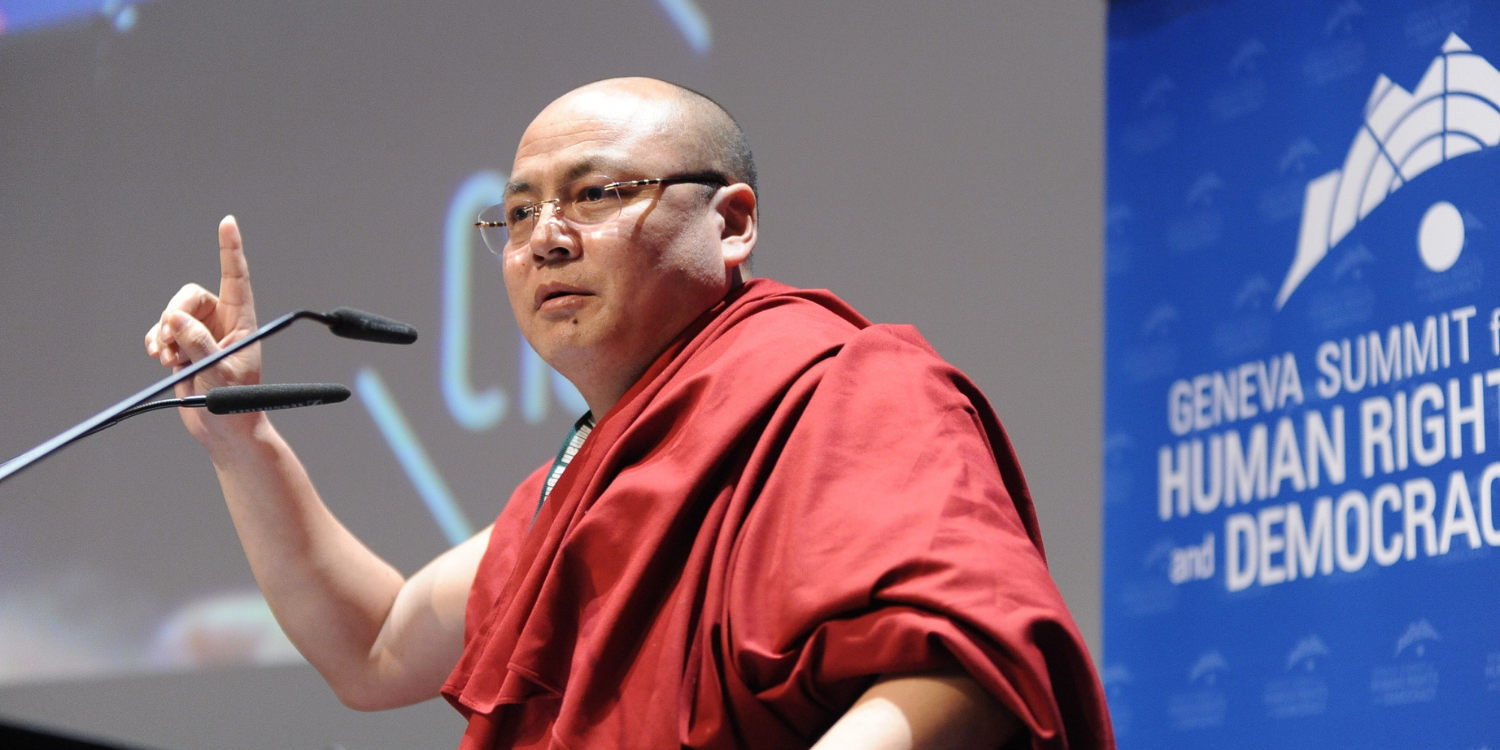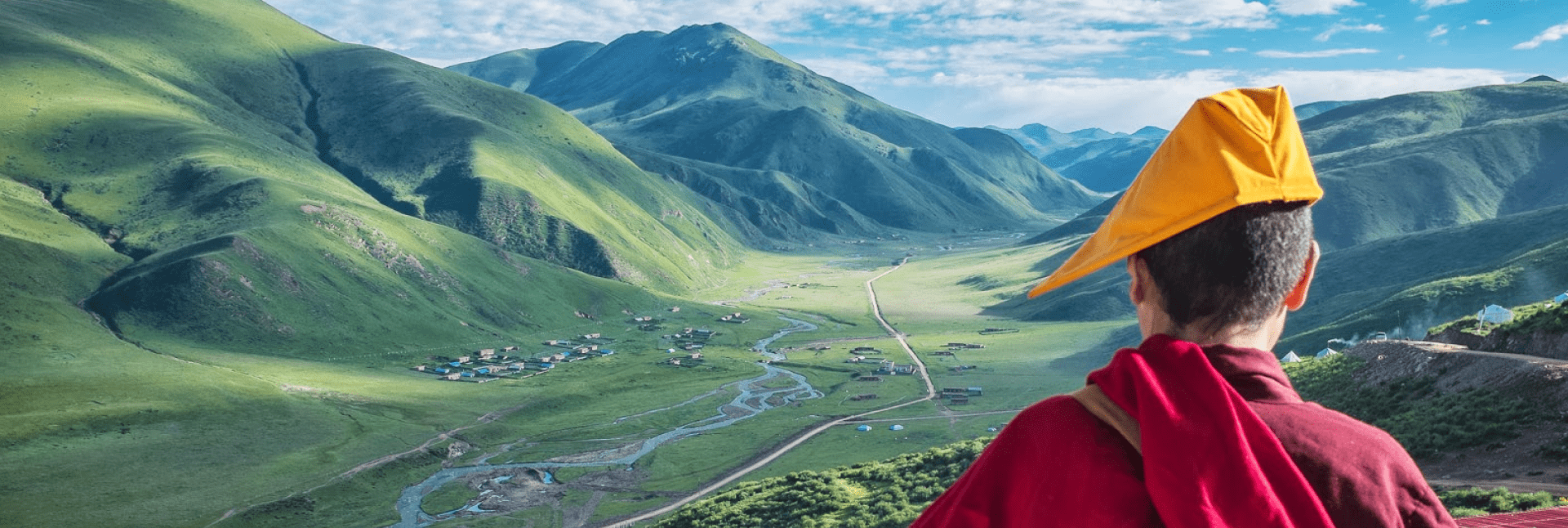Free Tibet has collected numerous case studies detailing the torture that political prisoners and other Tibetans are subjected to. The following are a small sample.
You can read an overview of torture in Tibet and our campaigning work on this page.
Golog Jigme

Golog Jigme in Dharamsala. (Photo by VOA)
“The authorities consider us Tibetans worse than animals. They do not value us as humans.” – Golog Jigme
Golog Jigme was first arrested on 23 March 2008 following his involvement in a film project. He was released and rearrested two more times before finally escaping to India in 2014.
On his first day in prison, he was hung by the ceiling by his handcuffs so that his toes barely touched the floor while two guards punched and kicked him to entertain themselves. When it got dark, he was taken down and instead handcuffed to the chimney of a hot stove. His arms, chest and face became burnt and blistered. He was then made to spend the night in a freezing cold room with all the windows open. He was unable to sleep due to the burns on his body and the low temperature, which gave him a fever. The following day he was hung from the ceiling by his handcuffs again.
After being taken to another place of detention, Golog Jigme was shackled to an iron chair in such a way that his legs and wrists bore his whole weight while his upper and lower body had nothing to lean against. While he was in this position, electric shocks were administered to him and he was kicked in the head while police interrogated him. He estimates he was tied to the chair for ten hours, except for around six intervals when he was removed from the chair and beaten on the floor. He was also beaten on the back with metal sticks, kicked and given further electric shocks. At one point he was hung forwards from the chair, in a position that made him feel that his chest might split, until, after two hours, an older policeman mentioned to the others present that putting someone in such a position for too long would kill them.
“The pain the chair caused was too extreme to feel any of the pain caused by the metal sticks and kicking. When they gave me electric shocks, I could feel nothing. I only smelt the burning of my own flesh.”
– Golog Jigme
By the time of Golog Jigme’s release on 12 May 2008, some of his ribs were broken, he had dislocated a knee and his other joints were suffering badly and he had sustained scars on his wrists and ankles from the restraints. He also sustained injuries to his spine, eyes, hands and feet. Some of his toenails fell out while he was in the chair due to his feet swelling up so severely.
While in detention he was only given small amounts of water, which affected him worse than usual due to the blood loss from his torture, and he was not granted access to a lawyer, doctor or any form of medical treatment. Neither his family nor his monastery were informed of his whereabouts.
Gonpo Thinley
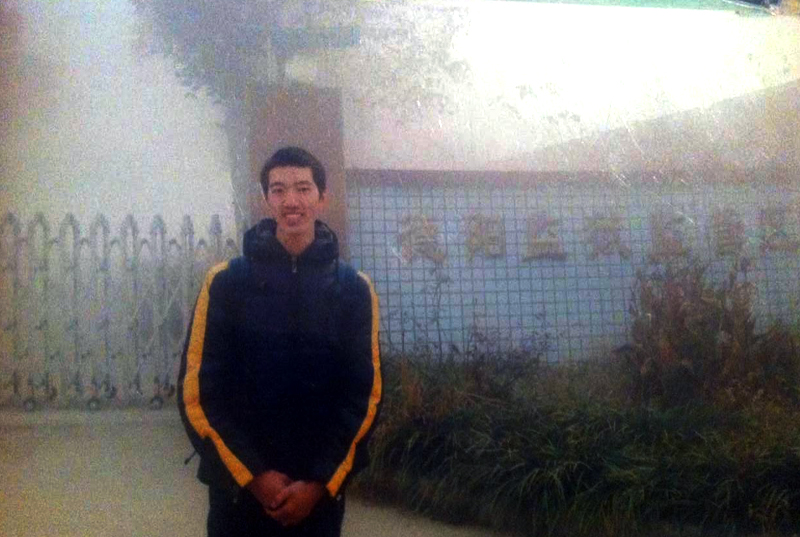
Gonpo Thinley outside Deyang Prison upon his release
“If our answers didn’t satisfy the interrogator, they would pour boiling hot water on us.”
Gonpo Thinley was arrested in Kardze County during a protest in 2008. He was beaten with sticks and guns by the security services, who took him to Kardze County Detention Centre without informing him of the reason for his arrest. His family and monastery were not informed of his detention or where he had been taken.
Upon arrival at the detention centre, Gonpo was stripped to his underwear. He was not given any covers for sleeping, even though the walls of his cell would end up covered in ice due to the cold. He was also not given adequate food or water, so had to drink the water from the latrine to quench his thirst.
During the first days of his detention, Gonpo was beaten so badly that guards had to carry him back to his cell because he could not walk. He was tortured over the course of about a month and a half with electric batons, metallic water pipes and handcuffs. He and a group of other prisoners were hung from the ceiling by their hands and beaten on the feet with batons. During cold days or winter, they would be put in cold water.
When in 2009 the farming community of Kardze County decided to protest, calling for the release of political prisoners, the military and other law enforcement agencies put them down, and then took prisoners, including Gonpo Thinley, to the main market area and paraded them. The following week they were taken to a prison and told that if they behaved well then they would be allowed to live, but if they didn’t then they would be shot dead right on the spot.
Gonpo Thinley was released in December 2010 but continued to be closely monitored.
Tenzin Namgyal
“They beat me fiercely and they said they were going to kill me. They said that however many people like me they killed, nobody would ever find out.”
Tenzin Namgyal was arrested in March 2008. During his detention at Kardze prison, he was kicked to the ground and beaten on the head with a bamboo stick, burned with electrical currents, hung from a door by his handcuffs and made to sit outside in cold water in his underwear. His feet stuck to the ice. Tenzin saw many other prisoners that were tortured and mistreated in the same fashion.
During one interrogation, several officers and Chinese officials removed his monk’s robes and forced him to kneel, before beating him and threatening to kill him. They held a gun to Tenzin’s head and fired it, then asked if he had anything to tell them. They beat him with the gun and hit his knees with an iron-covered stick, giving him scars on his knees that still remain.
“I thought I was going to die as many Tibetans had been killed by this kind of torture before.”
Political prisoners in prison with Tenzin had no mattresses or blankets. They were not allowed to pray or talk and were subjected to Communist party education. If they failed to sing the songs that they were instructed to sing then they were put in a small room with no room to stand up.
Tenzin’s family only found out where he was four months into his detention, when he managed to smuggle a message out to them. “At first when I was taken away my family and friends thought that I had died and later I heard they did many prayer offerings for me”. When his aunt came to the prison with clothes, food and money she was not allowed to hand them over, despite crying and pleading.
Tenzin was released on health grounds after a year and two months in detention. After his release, restrictions were imposed on his movement.
Lhamo Kyab
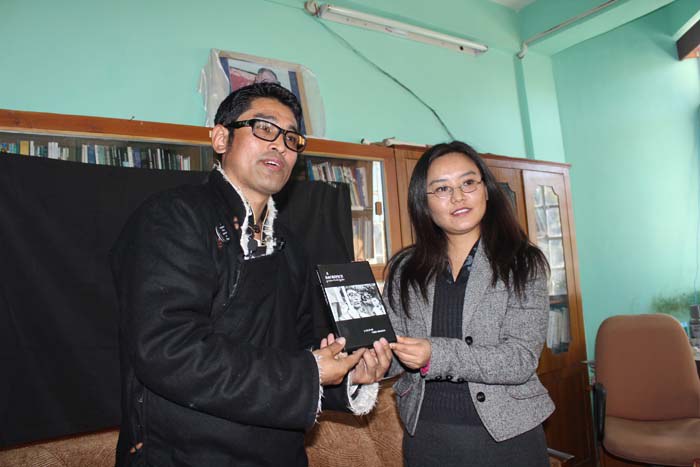
Lhamo Kyab (left). (Photo by TCHRD)
“I thought to myself, I’m sure to die in this wretched place.”
Lhamo Kyab, a thirty-year-old nomad from Amdo in eastern Tibet, first escaped from Tibet to India with his wife in 2003. In India, he studied the history of Tibet which instilled in him a sense of responsibility to act for a free Tibet. He decided to return to Tibet and fly the national flag over a holy mountain near his home in Machu.
He took the arduous journey through the Himalayas back to Tibet and arrived in early 2006. Upon returning to Tibet, Lhamo Kyab was arrested at his home before he was able to put up the flag.
He was taken to a detention centre where he was held for 11 months before any charges were brought against him. During this period in detention, Lhamo Kyab was the victim of routine torture. He was strapped to a metal chair that was welded onto the floor.
“They kicked me like I was a football.”
The severity of his injuries meant he had to be hospitalised several times, where he was chained to a bed. Lhamo Kyab suffered permanent damage to his liver and lost hearing in one ear as a result of repeated beatings in detention.
On 29 March 2007, the Lhasa People’s Intermediate Court sentenced him to three years in prison for the following “crimes”: possession of the Tibetan national flag, attempt to fly the Tibetan flag, illegal return from India and plans to undertake the act of ‘splitting the country’.
Lhamo Kyab was released in May 2009 and escaped to India again where he now lives as a refugee with his wife and children.
“Tenzin”
“It was very normal to be beaten and tortured in detention.”
To protect her identity, we have changed the name of this torture survivor. Tenzin was stopped and arrested at a border checkpoint after trying to escape Tibet as part of a group of six people. She was transferred to the county police detention centre, where she was locked alone in a cell with her arms and legs shackled. The cell was so small that only one person could fit in the room, and even then with little room to move around.
After several days she was moved to a labour re-education camp, where she was held for a year. While there, she was locked in a cell in complete darkness for several days and had to carry out hard physical activities such as carrying bags of sand and stones almost every day. During interrogations police would beat Tenzin with electric batons and belts. She lost consciousness several times, and on one occasion was beaten so badly that she lost all sensation in her body. Even when she was lying on the floor she would be kicked and if she lost consciousness she would later find herself handcuffed in her cell. On one occasion she was hung by her arms from the ceiling for an entire night.
Tenzin believes she was only released after the camp authorities noticed that she was close to death. The authorities summoned her relatives and made them sign a document guaranteeing that she would not get involved in any further activities that are against the law. A few years later she managed to escape to India.
Phuntsog Tsenam
“They took turns at beating me until the shovel handle broke into pieces.”
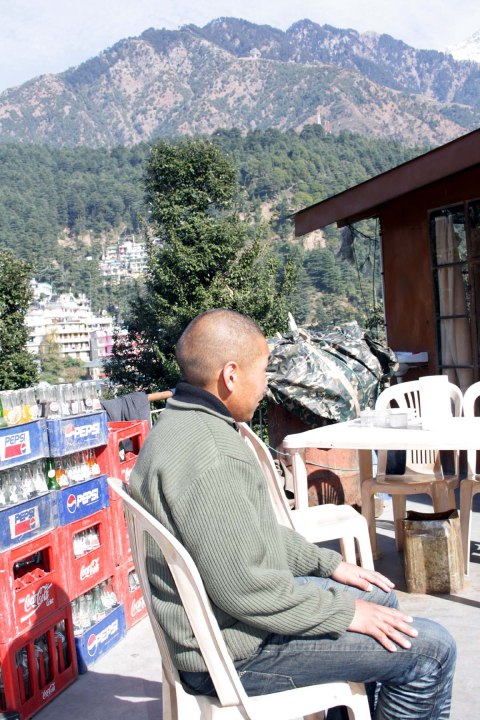
Former political prisoner Phuntsog Tsenam
Phuntsog Tsenam is a 33-year-old Tibetan monk from Lhasa.
Along with a hundred other fellow monks he participated in a peaceful march towards Lhasa on 14 March 2008. The monks were appealing for the release of two monks who were arrested two years earlier. Following mass protests in Lhasa in March 2008, the authorities imposed a severe crackdown. Phuntsog was detained on 17 April 2008 for unknown reasons and held for a year.
He suffered repeated beatings, including being forced to remove his robes and stand whilst guards took turns to beat him with a shovel until the handle broke. Phuntsog was told, “if you don’t speak I will break both your feet and hands. I will kill you.”
His family was not notified of his arrest and were not aware of his whereabouts for the whole year. He was moved to three different detention centres. No charges were brought against him and he never found out the reason for his year-long detention.
Phuntsog escaped from Tibet over the Himalayas in November 2008.
Pema
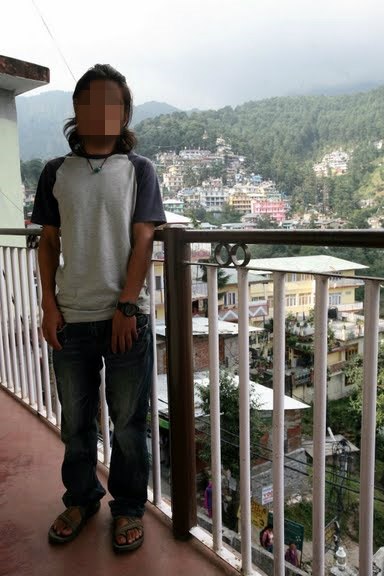
Pema, Tibetan torture survivor and refugee
“I thought that would be the last day of my life and all I wanted to do was see my parents.”
Pema was arrested by policemen at his home on the morning of 17 March 2008. During the arrest, he was beaten severely and was shocked by the use of an electric baton. As a result, he lost consciousness. He regained consciousness in a detention centre and found his arms tied with ropes. He was again brutally beaten. At midnight he was transferred to a storage hall at the local railway station where over one hundred other Tibetans were being held in appalling conditions. The detainees, including Pema, had to sleep on the concrete floor. There was no access to running water or toilets.
During interrogations, Pema was beaten. During one incident he was stabbed with a knife and burnt with cigarettes.
Pema’s family were not notified of his detention or his whereabouts as he was held in an informal place of detention, outside formal procedures of the arrest. He did not have access to a lawyer and did not receive medical assistance despite the torture he suffered during his ordeal.
He was released from the storage hall after three weeks without being charged with any crimes.
Pema now lives as a refugee in India.
Kelsang Tsundue
“Some of the prisoners would lose consciousness due to malnutrition.”
Kelsang Tsundue was arrested as part of a group of nine monks in March 2008, the day after his involvement in a protest. The monks were handcuffed together in pairs and then taken to a detention centre, where paramilitary police pulled them out of the vehicle and started beating them with batons and the butts of their guns. They were then put in an overcrowded prison cell containing more than 40 people. They were fed with leftover food from the prison staff that was watery and contained cigarette stubs
Two weeks later Kelsang and five other monks were separated, shackled in pairs and then taken to another prison in a vehicle while they sat on their knees. En route the vehicle was stuck in snowfall, so the paramilitary police accompanying the monks took their clothes and used them to cover the tyres. At the prison the six Tibetans were put in different cells, each containing Chinese prisoners, who mistreated them. The prison guards did not intervene, except, Keslang believes, to instigate the other prisoners.
Kelsang was later transferred to another prison where he made shoes across three shifts from 7am until 9pm. Prisoners were beaten or put in cages if they failed to complete the work.
When Kelsang completed his prison sentence he was dropped off at home secretly to avoid a big reception. Authorities did not inform his family of his release.

